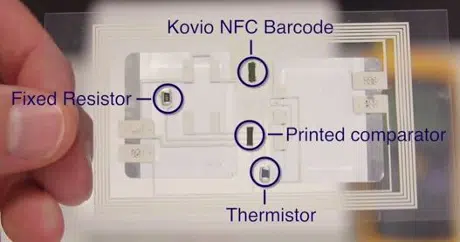
Printed electronics specialist Thinfilm has demonstrated an NFC-enabled label that includes a temperature sensor, which can be used to track a product throughout its journey to a store and report on whether or not the item has exceeded a particular temperature threshold at any point.
The demonstration, which shows the wireless capture of threshold excursion data from a temperature-sensing smart label, was presented by Davor Sutija, Thinfilm CEO, at Lopec, the international conference and exhibition for printed electronics. A video shows the technology in action:
The video shows how an NFC phone wirelessly detects the smart label’s signal and displays a corresponding alert on the screen, showing up red when the critical temperature threshold has been reached or exceeded during the supply chain, and green when it has remained within limits.
Because the smart label contains a unique ID in addition to the sensor data, it is possible to log the alert in a cloud-based application for further analysis, Thinfilm explains.
“If [retailers] have a shipment of blackberries, for example, they will be able to tell which ones received the most heat exposure in the truck and therefore which ones have the lowest shelf-life, so those will be the ones that you would want to shelf first,” Jennifer Ernst, executive VP of sales and business development at Thinfilm, explained to NFC World+.
“The data is being updated inside the label and all of the electronics are self-contained inside the label. So, it is an active monitoring system. For example, during the course of the shipment of a product, the label is actively gathering that information and monitoring for temperature excursion, independent of any infrastructure.”
“Consider a wine product,” Ernst continued. “Because you have the NFC identification, you can use this for verification. You can also monitor whether the wine was exposed during shipment. The labels are themselves intended to be disposable, one-time use, short lifespan-type applications, so [relevant for] things where you want to know something over the course of a few days time, a week’s time, perhaps as long as a month.
“They are intended really to be things that are embedding intelligence in objects to which, typically, you would not be able to add that structure. What we were excited about in using the NFC technology is the simplicity of the architecture surrounding it. It is the ability to really break from the hard-wired infrastructure.
“We also see areas like healthcare; being able to embed sensor elements that can be used as a diagnostic test, that can be used as a monitoring test and then, with an NFC-enabled phone, being able to tap and get that record right up into, for example, an electronic medical record. I think this will really start to open up some exciting possibilities.”
“It is the Internet of Things in the palm of my hand, that is really the way I think about it,” Ernst added. “In one hand is my object and in the other hand is my phone, and connecting them both. That is the Internet of Everything.”
Next: Visit the NFCW Expo to find new suppliers and solutions